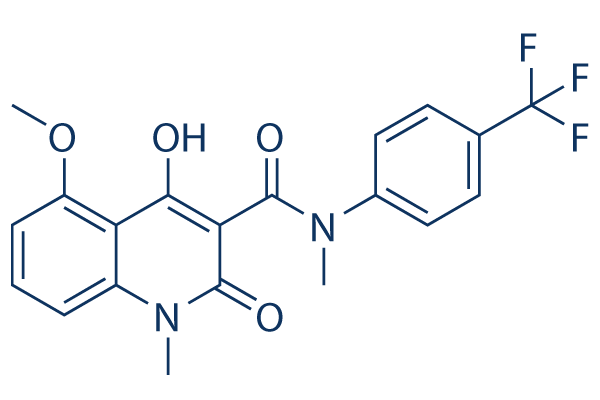| Cas No.: | 254964-60-8 |
| Chemical Name: | ABR-215050; ABR215050; ABR 215050 |
| Synonyms: | ABR-215050; ABR215050; ABR 215050 |
| SMILES: | CN1C2=C(C(=CC=C2)OC)C(=C(C1=O)C(=O)N(C)C3=CC=C(C=C3)C(F)(F)F)O |
| Formula: | C20H17F3N2O4 |
| M.Wt: | 406.36 |
| Sotrage: | 2 years -20°C Powder, 2 weeks 4°C in DMSO, 6 months -80°C in DMSO |
| Description: | Tasquinimod is an oral antiangiogenic agent in clinical trials for the treatment of castration-resistant prostate cancer. Tasquinimod binds to the regulatory Zn2+ binding domain of HDAC4 with Kd of 10-30 nM. |
| In Vivo: | The bioavailability and oral absorption of Tasquinimod is excellent when adult male mice (i.e., C57Bl/6J, or athymic nude mice) are given 0.1-30 mg/kg (i.e., 0.2-74 μmoles/kg) via gavage or the drinking water. The potency of Tasquinimod expressed as the daily oral dose of Tasquinimod which inhibits cancer growth by 50% ranges from 0.1-1.0 mg/kg/d (i.e., 0.24-2.40 μmoles/kg/day) against a series (n>5) of human prostate cancer xenografts in immune-deficient mice. Tasquinimod at a chronic dose of 5 mg/kg/day via the drinking water produces > 80% inhibition (p<0.05) of TRAMP-C2 mouse prostate cancer growth in immune-competent syngeneic mice[2]. Nude mice carrying subcutaneous LNCaP tumors are treated with Tasquinimod for 3 weeks. Exposure to Tasquinimod at 1 mg/kg/day and 10 mg/kg/day started on day 7 after inoculation. There is a statistically significant dose dependent reduction in tumor weight both at 1 mg/kg/day and 10 mg/kg/day compare to the untreated control group 28 days after inoculation (p<0.001), illustrating the anti-tumor effect of Tasquinimod[3]. |
| In Vitro: | Tasquinimod suppresses hypoxia induced decrease in histone acetylation without lowering HDAC expression or directly inhibiting HDAC activity. Tasquinimod binds allosterically within the regulatory Zinc domain of HDAC4 with a Kd of 10-30 nM, which results in inhibition of co-localization of N-CoR/HDAC3, thereby inhibiting deacetylation of histones and HDAC4 client transcription factors, such as HIF-1α. TAMs secrete angiogenic factors like VEGF, FGF, TNF- α, and TGF-β when myeloid-derived suppressor cells differentiate. Tasquinimod can suppress tumor angiogenesis due to inhibition of S100A9/TLR4 dependent MDSCs tumor infiltration and/or to inhibition of HDAC4/N-CoR/HDAC3 dependent deacetylation of HIF-1α by MDSCs suppressing their differentiation into TAMs.[1]. Tasquinimod, an orally active quinoline-3-carboxamide, binds with high affinity to HDAC4 and S100A9 in cancer and infiltrating host cells within compromised tumor microenvironment inhibiting adaptive survival pathways needed for an angiogenic response[2]. At 10 μM Tasquinimod, the TSP1 mRNA expression is elevated at 6 h and peaked after 72 h. Moreover, after 72 h exposure the TSP1 mRNA levels is already elevated at a dose of 1 μM Tasquinimod, indicating that Tasquinimod-induced changes in TSP1 mRNA expression occurrs in a dose range. At higher dose levels (i.e. 50-100 μM) the mRNA levels decline at 72 h, indicating additional drug effects at these concentrations. The up-regulation of TSP1 mRNA in LNCaP cells by Tasquinimod is manifested by an increased expression of TSP1 protein, as shown by western blot analysis of cell lysates prepared from cells cultured for 24 h and 72 h. Accompanied by increased intracellular TSP1 protein levels are also a statistically significant (p<0.05) accumulation of extracellular TSP1 in the cell culture medium detected. The extracellular secretion of TSP1 is time dependent and could clearly be detected after 24 h exposure to Tasquinimod at 10 μM. Also, TSP1 mRNA levels are induced by Tasquinimod at 10 μM in the hormone insensitive cell line LNCaP19 but not in DU145 cells[3]. |

 DC Chemicals' products qualify for U.S. tariff exemptions. We guarantee no price increases due to customs duties and maintain stable supply, continuing to deliver reliable research solutions to our American clients.
DC Chemicals' products qualify for U.S. tariff exemptions. We guarantee no price increases due to customs duties and maintain stable supply, continuing to deliver reliable research solutions to our American clients.





















